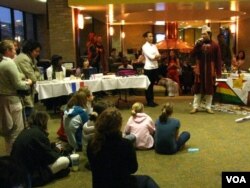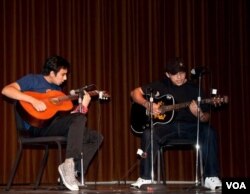"Namaste! I am Abhushan and I am from Nepal."
"Really? Have you ever climbed Mt. Everest?" "Do you live in the mountains?" "Do you pet Yetis back in Nepal?"
"Yes, I am from Nepal." "No I haven't climbed Mt. Everest because it is at a whopping altitude of 8850 meters." "I live in a big sprawling city with a population of almost 1 million people." “I definitely do not have a pet Yeti. I have a little yipper named "Sheru" who likes to stun and catch birds.”
A year back, these were typical questions that people in the U.S. would fire back at me when I introduced myself and my country to them. Whether it was a normal conversation or an email, such questions almost became inevitable. It was annoying at first, seeing people who have no idea about my country and my culture talk to me so stereotypically. Sometimes, out of rage, I wondered how these people who have no idea about geography are ruling the world right now!
But, after mingling with the American community for a year, I slowly understood why that happened. I simply put myself in their shoes and then understood that I would not have known about a small country sandwiched somewhere in the heart of South Asia, given the same kind of upbringing and environment. At the same time, this thought also inspired and constantly pushed me to share my Nepali culture and tradition with the Americans.
Wooster – the college where I am from – is a small and tight-knit community with diversity in the population. People are well-acquainted with more typical South Asian cultures like India and Pakistan here, given the long history of having students from these regions. But sadly, Nepal still remains a mystery.
There is hope - the Nepali community has successfully grown to 5 this year. Yay! But still, wearing a t-shirt that says "I love Nepal" or talking to people in my “weird” accent simply wasn't going to draw the interests of Americans into my Nepali culture. Therefore, I tried to share my culture in a more fun way.
The picture to your right shows an image of a celebration of a Nepali festival in Wooster. And, I guarantee you that there was no stampede after this photo was taken. :)
The festival we were celebrating is called Dashain. It is pretty much a mega-festival - like Christmas for Christians. My classmates from Nepal and I had planned the event simply out of homesickness, and it started with just two or three of us preparing a Nepali dish and conducting the proper rituals.
But when people saw us celebrate and don the red paint – called "tika" - on our foreheads, they too had the urge to join in. And, in no time the kitchen was flooded with new faces from California, Alaska, Pakistan, Thailand, Ethiopia and South Korea. The picture speaks for itself and the kind of experience that we all had that day.
This taught me something. Until you make an effort from your side to share your culture with others, nobody is going to come looking for that guy who just arrived from Nepal or Guam. Similarly, it is equally your duty and responsibility to make people around you aware of your culture if you are the one who complains that they lack that awareness. Once you do that, I am sure people will not just like your culture; they will be envious of it.
The next event that I used to share my culture with the American community was the International Education Week organized in our college.
During the week-long event, we not only dressed ourselves in the best Nepali dress but also sang and danced to the tunes of Nepali and popular Bollywood numbers like "Jai Ho" from Slumdog Millionaire.
I carry some of the best memories of my first year from these events, which I will cherish forever in my life. Similarly, I am sure that the American audience at Wooster too relished the gala.
Thanks to these events, the Nepalese tradition, here in Wooster, continues. People now know what Nepal is or what its 'unique' national flag is shaped like. Some even know how to cook Nepali delicacies. They know that "Namaste!" translates to "I greet the God in you." They know about most popular places to go hiking in Nepal, Nepali songs and tunes, the dress, and most importantly- and to some extent- they know what it's like to be a Nepali.
Imagine that you are eating a medium-size pizza all by yourself. And, now imagine that you are eating that same pizza with your best friends. Do you understand the difference? I am sure you do. Sharing your culture in the U.S. is similar. The only difference is that the other people won't be your best friends right away. You will have to put in the effort to make them friends. But it is worth it - sharing your culture not just serves for your benefit or others; it is mutually enriching.
To put it straight: SHARING is simply CARING!







